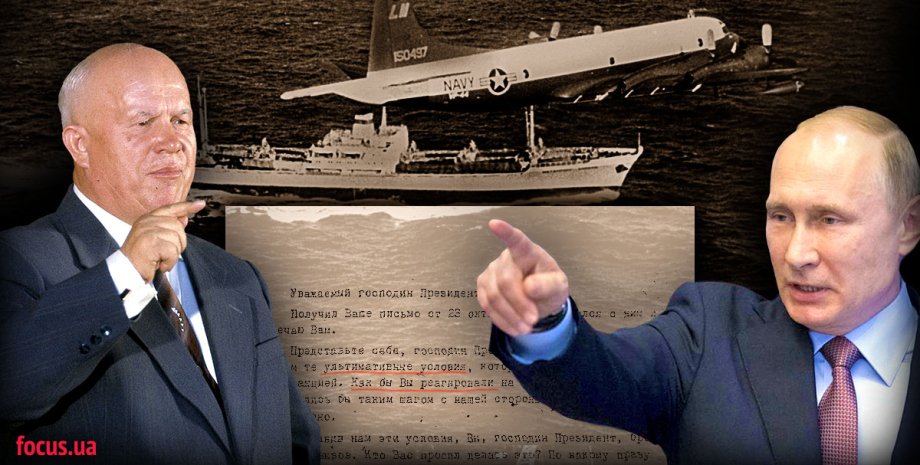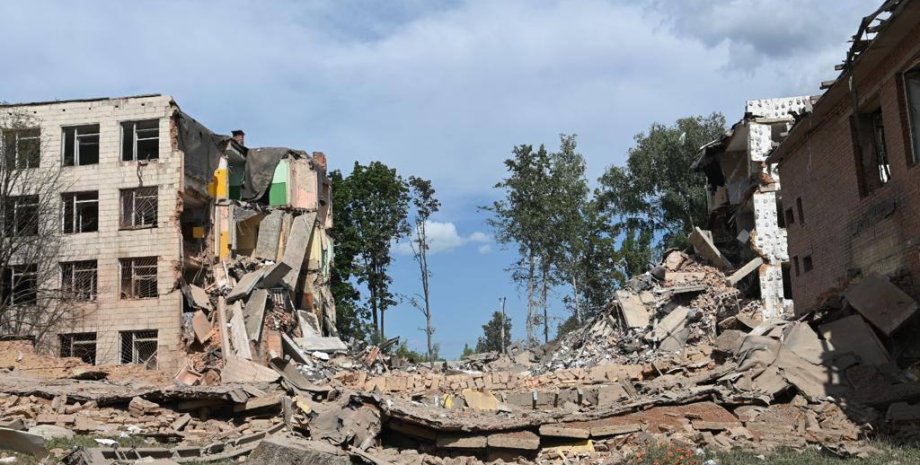
 By Eliza Popova
By Eliza Popova
The USSR and the US, two superpowers that possessed nuclear potential, which, according to certain estimates, was enough to destroy humanity several times, went a step towards the use of nuclear weapons against each other: from October 16 to October 28, 1962, the Caribbean crisis lasted. It seemed that everyone made the proper conclusions, and it would never happen again.
However, only a few decades have passed - less than the average life expectancy of one person - and two superpowers are again on the verge of escalation. Only this time was the USSR replaced by the Russian Federation, which took away the entire nuclear arsenal of the former Union, in particular, a significant part of it in Ukraine, which now threatens to use weapons of mass destruction.
Focus mentioned the "golden autumn" in 1962, which, due to the confrontation of the USSR and the US, almost became the last for humanity, and asked experts about whether a new Caribbean crisis was possible today. After the Second World War, the former allies, the USA and the USSR entered the fierce confrontation.
The reason was dramatically opposite ideologies that professed in the United States (capitalism and ideas of the free market) and the USSR (socialism with the subsequent desire of transformation to communism and planned economy). Ideology is so antagonistic in essence that geopolitical opponents were doomed to confront almost every area of human life - from space program to the use of toilet paper in everyday life.
It is interesting that when the space program was practically the end of the confrontation, the household sphere became the Achilles Fifth of the USSR, which the United States did not lose the opportunity to use. Direct confrontation did not occur because initially the United States (1945) and then the USSR (1949) was acquired by nuclear weapons, the use of which potentially led to excessive number of casualties, which no one wanted to allow.
Over time, the arsenals reached such a size that they began to assume that their simultaneous use can lead to the death of all humanity on the planet. Therefore, nuclear weapons were called restraint weapons, and the confrontation between the two hegemons - the "Cold War", that is, without a hot phase, a direct clash of both armies. The Cold War Strategy was surrounded by a rival nuclear weapons on all sides, so that in the event of exacerbation, it simply could not strike.
For this purpose, submarines, strategic planes and ground base were used. In 1959, the United States managed to disrupt parity in the last component by placing nuclear weapons, namely Medium-Range Missiles PGM-19 Jupiter, in Turkey (NATO, since 1952), that is, close to the Soviet border.
However, Washington did not take into account that in Cuba, which is located 140 km from the American state of Florida, in 1959 the socialist government of Fidel Castro came to power, which established an authoritarian regime similar to the Soviet one. The unsuccessful attempt to plant a landing of the opponents of the new government in the Gulf of pigs in the spring of 1961 only contributed to the rapprochement of both socialist states.
In the capital, Havana Cuba understood that without the support of a powerful ally, the regime could not withstand - sooner or later the United States would still have a successful operation. There is also a version that even the success of pig bay would not be possible without the help of the USSR, which kindly shared with the Cubans intelligence. In Moscow, however, they grabbed a chance to get an ally close to the American borders.
At that time, in addition to the maritime border between the United States and the USSR (through the Bering Strait), two NATO members - Norway and Turkey had common borders from the USSR. Therefore, Moscow and Havana agreed on the placement of the Soviet military contingent in Cuba. The world was approaching an armed conflict, which with a high probability could develop into nuclear.
During the Second World War, two atomic bombs were dropped to Japan, which during the fighting actively used chemical weapons, but it did not have nuclear. What if the two sides of the war use their nuclear arsenal, no one was predicted. The world froze in anticipation of irreparable. Like such dramatic events, the circumstances in which the Caribbean crisis broke out, eventually began to overgrown semi-legendary-conspiracy theories.
In particular, there is a version that in the process of blockade, American destroyers attacked a Soviet submarine that tried to break it. As a result, the submarine lost connection with the outside world and its commander, deciding that the war began, ordered the launch of a nuclear missile (according to some versions, it was a torpedo). However, he was refused by one of the senior officers of the vessel, who, if these events really happened, saved humanity.
Also common is the version of parallel negotiations, which was either a journalist close to the White House, or the US President's brother with a Soviet resident. It was at these negotiations that they allegedly reached agreements on escalation removal. The fact that happened is that on October 27, an American U-2 reconnaissance aircraft was beaten over Cuba, and a 35-year-old pilot, Major Rudolf Anderson, died.
It was already the boundary of the confrontation, because in the case of the US troops, the escalation would no longer be stopped. However, the day before, the USSR leader Nikita Khrushchev sent Kennedy a telegram with a proposal of negotiations. He suggested taking away Soviet Cuba missiles in response to the Nonpad's Guarantee to the US island.
And on October 27, after the incident with the reconnaissance aircraft, Khrushchev proposed to remove rockets in exchange for a similar step with American missiles in Turkey. This, in particular, gave rise to the version that the plane was not agreed with Moscow. Then the Kremlin realized that they did not fully control the situation, and this contributed to their initiative to negotiate.
This incident remains a reminder that in the case of excessive escalation, everything can solve one careless shot. The United States officially agreed to the conditions of the first message (rockets in exchange for the guarantees of the non -aggression) on October 28, which marked the end of the Caribbean crisis. In December 1962. at. The UN Secretary General arrived in Cuba and stated that there was no more Soviet weapons there.
According to the version with parallel negotiations (which, most likely, the question is in what format), the United States agreed to dismantle their missiles in Turkey under the pretext of their outdance, which actually happened in 1963. So publicly the United States was the winner of this confrontation, as they have achieved the retreat of the USSR from their borders. In 1963, an agreement was signed by a ban on nuclear testing "in the atmosphere, outer space and underwater.
" In the future, both camps in journalism, cinema, literature and other spheres of culture launched a rhetoric against nuclear confrontation. Post -apocalyptic scenarios awaited the world in the event of nuclear confrontation were depicted. Treaties that contributed to the inhibition of "arms race" were signed between the USSR and the US, at least in the nuclear sphere. Also between the White House and the Kremlin spent a "hotline" for direct negotiations in case of repeating something like that.
With the collapse of the USSR, there was a hope for nuclear disarmament. For the first time in history, Ukraine, Belarus and Kazakhstan created a precedent of nuclear disarmament, abandoning nuclear weapons in exchange for security guarantees. Our state has given the third nuclear arsenal in the world. What is the future in the process of nuclear disarmament after Russian aggression against Ukraine is a rhetorical issue. It was nullified by the annexation of Crimea.
Now Ukraine is threatened, in fact, its arsenal. The Kremlin considers the retreat of the USSR during the Caribbean crisis, and Khrushchev is weak, and in recent decades it has been ridiculed in every way. The policy of modern Russian authorities is based on revenge and desire to "re -play" again. Therefore, to be on the site of Khrushchev is a real way for the modern Kremlin owner, the opportunity to put his rhetoric in reality. The parallels, of course, are not complete.
There is even a certain element of reflection, because now the US is protecting the far country from its neighbor's aggression and its geopolitical rival. A better example would be the situation with Taiwan, which is also an island. The uniqueness of the Ukrainian situation is that Kyiv voluntarily abandoned nuclear weapons in 1994, creating such a precedent. From this point of view, even the annexation of Tuzla island could already launch long -term but irreversible processes.
Aggression is initially hybrid and then full -scale with subsequent annexation of all new territories against the country, which abandoned considerable nuclear potential - from the country that received it and also guaranteed the safety of its victim.
Which precedent can cause more harm to world order and safety? It is no longer about the disarmament of the "nuclear club" states, but what factors will now make the idea of nuclear weapons other countries that apply for independent policy: from Brazil to Indonesia and Saudi Arabia? In fact, irreparable harm has been caused, and the lack of convincing punishment of the aggressor-charm (which does not comply with the obligations taken) will launch a reverse count to the war between nuclear powers, which in this case will become inevitable.
To get a complete idea of how significant the nuclear threat is today, focus has addressed experts. Volodymyr Gorbach, political analyst at the Institute of Euro-Atlantic Cooperation, expert on foreign and domestic policy of Ukraine: I will not be original about this issue when I will say that all these states will be administered to the use of nuclear weapons negatively, with condemnation. No one will approve, and no one can refrain from condemning to choose a neutral position.
Everyone will be condemned at least in words. Anna Shelest is the Director of the Ukrainian Prisma Foreign Security Programs: in this case, it is wrong to call China and India neutral states because they are nuclear. In the use of nuclear weapons, they can no longer be called neutral countries as they try to partially represent in the political sphere. The Nuclear Power Club has certain obligations and certain principles they prescribed.
It would be important for Ukraine to hear China and India's position on the Kremlin nuclear blackmail. As for China, it is also difficult to call it neutral about the possible use of nuclear weapons against Ukraine, since this state has actually signed the Budapest Memorandum. The Middle Kingdom, together with France, later became the signatories of the memorandum. One of the points has a norm for non -use of nuclear weapons against Ukraine, and their position is important here.
Vladimir Gorbach: The reaction was announced to me. They said that the reaction would be kinetic - it would be a force stroke. I do not think that the reaction will be with the use of nuclear weapons as it will stimulate further escalation. The reaction will be power but non -nuclear. This will be done for reasons not to raise the rate. Such an answer will be preschool and deprive Russia of this conflict. The use of high -precision, destructive and deadly weapons on installations and launch points.
Tactical nuclear weapons can be applied from the occupied territory of Ukraine along the front line. If it is launched from the occupied territory, then there will be a response to these points, if from the Russian territory - less likely to strike. However, there may be blows to Russian troops, which are located in the occupied territories, including the Black Sea Fleet of the Russian Federation.
Anna Shelest: Brussels is currently actively discussing the issues of NATO's reactions to nuclear weapons. Article 5 of the Collective Security Treaty said clearly about the attack, and only recently spelled there a norm for cyber attack. If a radioactive cloud goes to the Alliance, it is not an attack. Some American generals even propose to break the Black Sea Fleet of the Russian Federation when using it.
Asymmetrical actions are possible, but today no one will be able to say clearly what they will be. Volodymyr Gorbach: Everyone will look at the US, they have the largest arsenal of nuclear weapons and a variety of ways to deliver these weapons. The whole world will look at the United States and their reaction. Mykola Sungurovsky, Military Expert Razumkov: It is possible that 2-3 days will pass.
It all depends on how complete the preparation for the tactical nuclear stroke was and whether warheads were brought to the troops. The transportation of this type of weapon depends on what transport it is delivered - rail or aviation. When it comes to tactical nuclear weapons, these are mobile launchers. It can be artillery, missile installations or weapons installed on a ship. It is difficult to talk about "suppression" here, everyone needs to follow, but this is a difficult procedure.
It's also difficult to predict. The US does not open their cards completely. Will there be a blow to the Russian territory? They are silent and do the right thing. The uncertainty element is additional work for Russia. Recent events, when Lukashenko agreed to deploy a joint group of troops . . . It is possible that some launcher with nuclear ammunition will be transferred to the armament of this group.
And then the task becomes more complicated, because the decree will be forced to decide who used nuclear weapons and which country to strike. It is dangerous to draw a nuclear stroke in the Black Sea. The Black Sea is special because it has a high concentration of hydrogen sulfide. The entire Black Sea basin can explode, and it will be an environmental disaster of a planetary scale. Over the Black Sea - can. As a demonstration act. Definitely so.
Initially, they will apply ordinary weapons, which in their potential is not inferior to nuclear. There will be sighting strokes at the storage sites of nuclear warheads, on the identified positions of the means that use nuclear weapons. Perhaps on decision -making centers. The NATO strategy is secret, and this issue can only be guessed. It is an element of uncertainty that is most terrified by the enemy.
The carriers of strategic nuclear weapons of the Russian Federation are already aimed at some goals in the territory of the United States. There is no point in applying strategic nuclear weapons in a non -nuclear state. Are there any threats to the 60s of the 60s and is the repetition of the Caribbean today, but with other scale? We asked Alexander Har.
The diplomat, the Assistant Minister of Defense of Ukraine in 2020, considers the expert of the Center for Defense Strategies as follows: to use nuclear weapons against Ukraine from a military point of view is madness. This will not produce the expected result, and the negative consequences will be for Russia, even if they do not strike in its territory. It is about storage tactical nuclear weapons.
Initially, there should be a certain situation where the Russian leadership decides that they do not have methods to influence Ukraine, and then they will make a political decision on the application of the application, which they still have to be delivered to the relevant positions. It is rumored that they want to show their determination in the question "I do not bluish", somewhere at the landfill. They use nuclear weapons not against Ukraine, but in their territory.
Or maybe nuclear weapons are used somewhere in neutral positions in the Arctic to intimidate the civilized world. The goal is called the Snake Island. This is more symbolism than military logic. I cannot say exactly how much time it should take from the decision to use. This is too hypothetical. When it comes to the use of nuclear weapons in neutral or Russian territory, no one will raise the issue of strike on the Russian Federation.
If it is in the territory of Ukraine - the answer will be non -nuclear. The US has sufficient potential to cause significant damage that will be comparable to nuclear weapons. They will not enter this spiral confrontation for further escalation of the conflict. The impact can be struck in the Russian Federation if the Russians go down and start doing something with their strategic nuclear weapons, which is already given in the US.
I think there is no parallel between the Caribbean crisis and the present events, because then the interests of the two states that were on the verge of nuclear conflict with each other. The fact that Russia is now frightening is another matter. They are vaguely trying to say that they can strike a nuclear blow to the US and Europe, but it is a beacon. They understand that there will be a blow. Americans cannot leave it unanswered and it will be the end of humanity.
Колишні американські посадовці, серед яких Герберт Макмастер (ексрадник Трампа), Веслі Кларк (генерал США), Бен Годжес (екскомандувач силами США в Європі), кажуть, що США можуть нанести удари по російських військах на Донбасі, у Криму, а також у Херсонській і Запорізькій областях.










All rights reserved IN-Ukraine.info - 2022